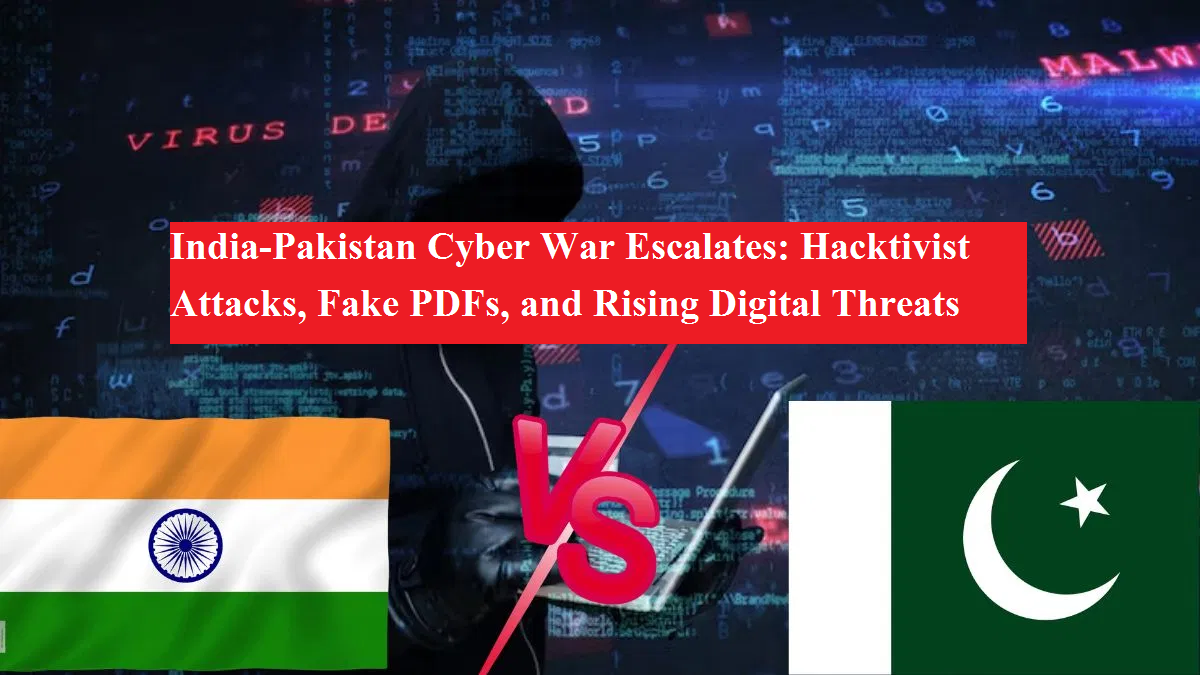India-Pakistan Cyber War Escalates: Hacktivist Attacks, Fake PDFs, and Rising Digital Threats
- byManasavi
- 01 May, 2025

While India and Pakistan remain locked in long-standing geopolitical tensions, a new battlefield has emerged in cyberspace. As border confrontations escalate, so too do cyberattacks by hacktivist groups, targeting government websites, critical infrastructure, and spreading malware through fake documents and phishing websites.
This digital warfare isn’t just a tech issue—it has become a strategic tool capable of shaking national security and public trust.
⚔️ Cyber Front Heats Up After Pahalgam Terror Attack
Following the recent terror attack in Pahalgam, Jammu and Kashmir, diplomatic relations between India and Pakistan have once again hit a boiling point. But beyond the headlines of border skirmishes and political threats, cyber warriors from both nations are actively engaged in digital combat.
In the last week alone, Indian hacktivist group “India Cyber Force” claimed responsibility for breaching databases of multiple Pakistani entities, including:
- Euro Oil
- AJK Supreme Court
- Balochistan University
- WADA Call Agency
- Sindh Police
In retaliation, Pakistani group “Team Insane PK” allegedly defaced the official website of the Indian Army College of Nursing, replacing its homepage with provocative and religious messages.
🛡️ Multiple Cyber Attacks Foiled by Indian Agencies
Cybersecurity agencies in India have reportedly neutralized several recent attacks originating from across the border. According to experts, Indian defense and key government systems were targeted, but successful mitigation efforts helped prevent major disruptions.
One major phishing threat came disguised as a PDF file titled "Report & Update Regarding Pahalgam Terror Attack". The file, circulating online, was linked to a fake domain (indiadefencedepartment[.]link) and aimed to trick users into downloading malware.
🧑💻 APT36 and SideCopy: Pakistan-Backed Cyber Espionage Groups
Cyber intelligence reports have identified the involvement of APT36 (Transparent Tribe), a Pakistan-based Advanced Persistent Threat (APT) group. This group is known for its use of CrimsonRAT malware and MeshAgent tools to conduct espionage operations.
In addition, a sub-group called SideCopy has been launching attacks on Indian infrastructure, especially in the railway and oil sectors, using sophisticated tools like CurlBack RAT, designed for stealth surveillance and remote data access.
🚨 Rising Threat to Citizens: Stay Vigilant Against Phishing
This growing cyber conflict is no longer limited to government servers. Ordinary internet users are now prime targets, especially through:
- Fake websites imitating defense or government agencies.
- Phishing emails containing infected PDF files.
- Social media campaigns designed to manipulate opinions or steal personal data.
Security experts urge users to avoid opening unverified attachments, especially those claiming to relate to national security or current events, and to check for HTTPS URLs and official domains before clicking.
🎯 Strategic Weapon in Modern Warfare
The ongoing cyber conflict between India and Pakistan reflects a larger global trend: state-backed cyberattacks becoming a core component of modern hybrid warfare. Unlike traditional battles, cyberattacks can be launched silently, anonymously, and with far-reaching consequences—disrupting essential services, leaking sensitive data, or sowing public fear.
Digital Vigilance Is the Need of the Hour
As tensions rise on both the physical and digital fronts, cybersecurity must become a national priority. Governments must strengthen digital infrastructure, and citizens must remain alert to phishing traps and misinformation. In this new era, keyboard warriors are just as powerful as boots on the ground.






